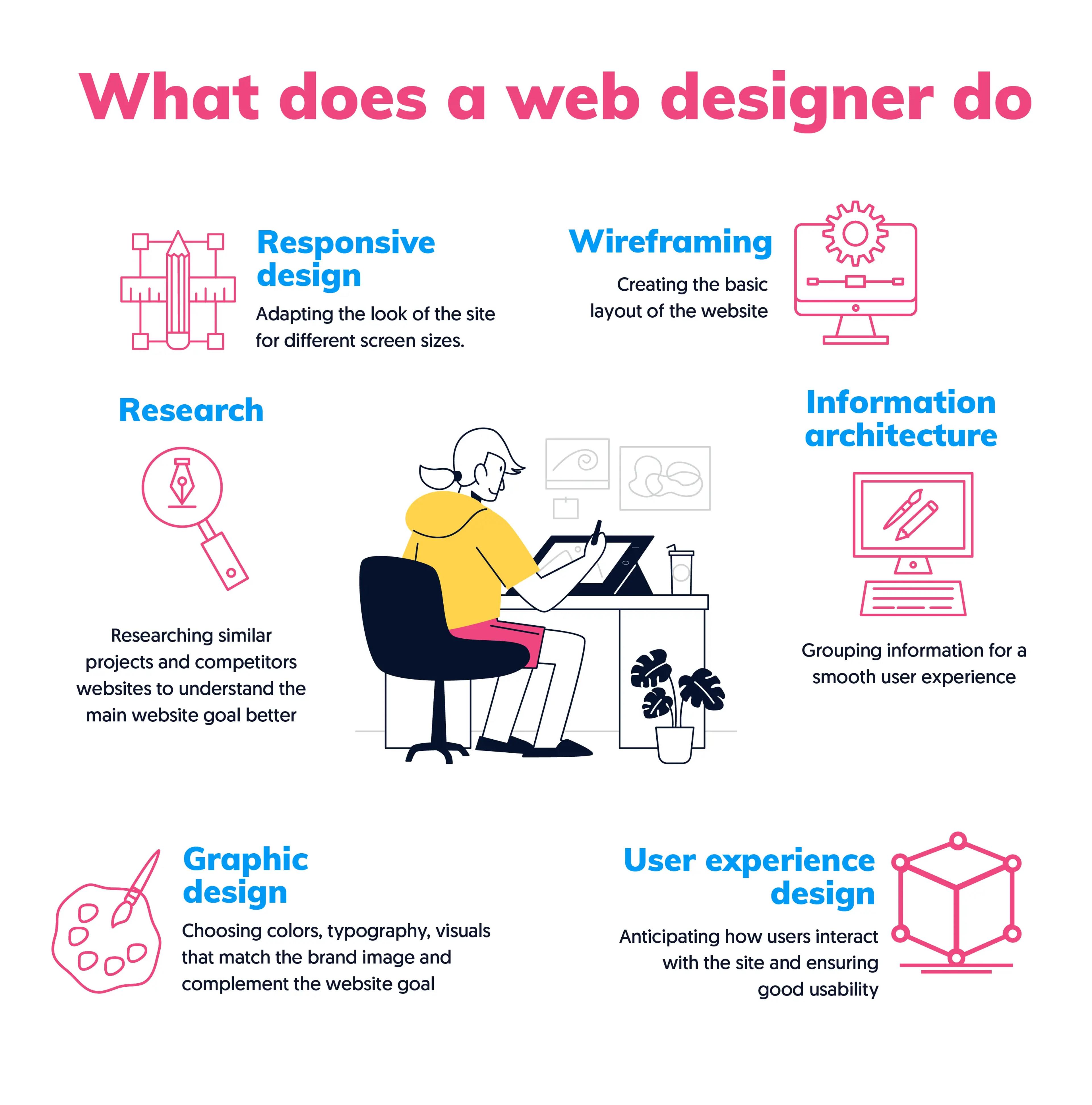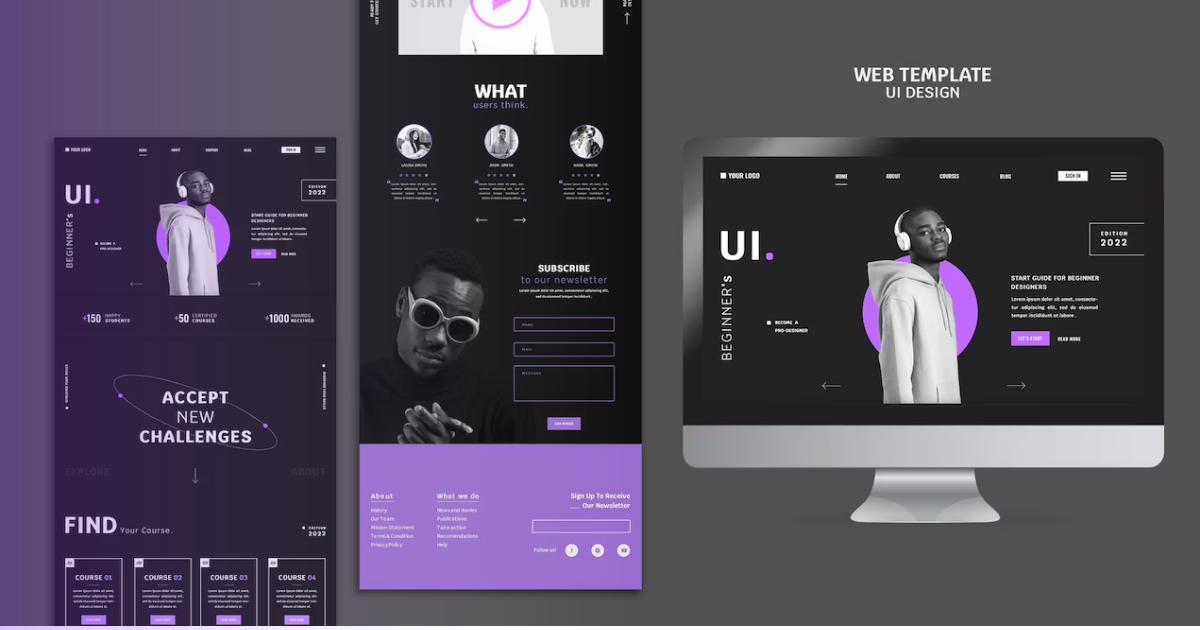Web Design London Ontario Specialists for Personalized Projects
Web Design London Ontario Specialists for Personalized Projects
Blog Article
How to Efficiently Incorporate Visual Appeals and Performance in Internet Layout
When making a site, you need to strike an equilibrium between aesthetics and capability. It's not simply about looking excellent; your design needs to also offer a purpose and overview users efficiently. By concentrating on simpleness and intuitive navigation, you can develop an interesting experience. Yet what elements absolutely enhance usability while maintaining aesthetic appeal? Allow's discover the key concepts that can cause an unified blend of charm and function.
Recognizing the Importance of Appearances and Functionality
Recognizing the balance between appearances and capability is crucial for creating an efficient user experience when you develop a web site. An aesthetically attractive website grabs interest, yet it's the functionality that keeps individuals engaged. If your site looks wonderful however is tough to browse, site visitors will rapidly shed passion and leave.Consider your target market and what attracts them in. You wish to produce a style that shows your brand name while guaranteeing ease of use. Structured layouts, intuitive navigating, and clear phone calls to activity can enhance both aesthetic appeals and functionality.

Principles of Efficient Website Design
To produce an efficient website design, you require to follow several key principles that boost both individual experience and aesthetic appeal. Initially, prioritize simplicity; a tidy format helps users browse conveniently. Use a consistent color design and typography to keep comprehensibility throughout your site. This fosters familiarity and trust.Next, assure your style is receptive. Users gain access to websites on numerous devices, so your design ought to adapt flawlessly. Take notice of visual hierarchy; highlight essential elements with placement, shade, or dimension to direct users' focus.Finally, incorporate adequate white room. It prevents mess and makes material extra absorbable. Bear in mind, efficient website design equilibriums aesthetic appeals and capability, so every style option should offer an objective. By complying with these concepts, you'll create a website that's not only visually enticing however additionally easy to use, inevitably keeping site visitors involved and urging them to return.
Prioritizing Customer Experience
When prioritizing customer experience, you'll wish to begin by recognizing what your customers genuinely need. Streamlining navigation design can make a massive difference in just how conveniently they discover what they're trying to find. Likewise, boosting visual hierarchy assists guide their focus to the most important aspects on your site.
Understanding User Needs
Understanding user demands is important for producing an appealing web experience that keeps site visitors returning. To achieve this, you have to recognize the objectives and choices of your target market. Start by performing individual research study, like surveys or interviews, to gather insights on what users worth most. Take notice of their discomfort points and obstacles when interacting with similar websites. This info allows you to customize your style, making certain performance straightens with individual assumptions. Additionally, consider developing customer characters that represent various sections of your target market, aiding you imagine their demands during the style process. When you focus on understanding individual requirements, you create an internet site that not just looks great yet likewise delivers a smooth, satisfying experience that promotes commitment.
Streamlining Navigating Layout

Enhancing Visual Pecking Order
A strong aesthetic hierarchy is essential in directing users with your website and ensuring they engage with vital material. To achieve this, utilize color, spacing, and size strategically. Make important elements like headings larger and bolder than body message, drawing attention promptly. Use contrasting shades to highlight phone call to activity, motivating clicks. Additionally, employ enough white area to separate areas, making content absorbable and inviting.Consider the flow of info; prepare components rationally, leading users' eyes from one indicate the following. Use visual hints, like arrowheads or lines, to guide focus. By prioritizing visual pecking order, you enhance customer experience and raise the possibility of conversions, guaranteeing your web site is both visually pleasing and functionally reliable.
Shade Theory and Its Effect On Functionality
While choosing the ideal colors for your internet site may feel like a minor information, it substantially influences use and customer experience. Color affects just how individuals perceive details and can hinder or enhance navigation. Contrasting colors can help important components stand out, making it much easier for site visitors to locate what they need.Additionally, think about the psychology of shades: blue frequently motivates trust, while red produces urgency. Recognizing your target market can lead your color selections, ensuring they resonate well.Moreover, consistent color pattern aid develop brand identity, making your web site a lot more unforgettable. Nevertheless, beware-- a lot of shades can overwhelm customers. Adhere to a minimal palette that complements your content and preserves clarity.Incorporating accessibility is likewise essential; verify your shade combinations are friendly for those with visual impairments. By thoughtfully applying color theory, you'll boost use and develop an extra interesting customer experience.
Typography: Harmonizing Style and Readability
Shade selections set the stage for your website, but typography plays a just as necessary function in boosting individual experience. You desire your message to communicate plainly while likewise mirroring Bonuses your brand's individuality. Begin by choosing font styles that are not only appealing but likewise clear. Sans-serif typefaces frequently function well for digital displays, as they're much easier to read at different sizes.Maintain a hierarchy by using different font style dimensions and weights; this guides customers through your web content easily. Take into consideration line spacing and letter spacing; also limited can discourage readers, while also loosened can disrupt the circulation. Limit your typeface choices to 2 or 3 to keep the design cohesive.Finally, always examine your typography across different devices and browsers. What looks good on one screen may not on an additional. Stabilizing style with readability guarantees that your message reverberates, maintaining your audience informed and engaged.
Receptive Style: Making Visual Appeals Work With All Devices
To guarantee your website looks excellent on any type of tool, you'll need to accept responsive style concepts. This method warranties your website adapts to various display dimensions, giving an excellent user experience. Beginning by utilizing liquid grids and adaptable photos that scale perfectly. As opposed to repaired dimensions, choose percentages and family member systems, permitting your layout to change dynamically.Next, execute media inquiries in your CSS. These allow you apply different designs based on device qualities, like screen width. This method, you can keep aesthetic charm while guaranteeing functionality.Don' t ignore touch targets; ensure buttons and links are simple to tap on smaller displays. Prioritize vital material, so users can easily browse your website no matter of their gadget. By concentrating on these elements, you'll create an interesting, visually appealing experience that meets the demands of all individuals, whether they're on a tablet, desktop computer, or mobile phone .
Conducting Usability Screening for Constant Enhancement
To improve your website design, you need to establish clear functionality objectives that line up with individual demands. By carrying out user examinations, you can gather beneficial feedback on exactly how genuine individuals communicate with your site. Assessing these results will help read review you make notified renovations and produce an extra effective customer experience.
Defining Use Goals
While aesthetic appeals can draw individuals in, specifying usability goals is crucial for ensuring their experience remains smooth and enjoyable. Begin by determining what you desire users to accomplish on your site (website design london Ontario). Consider their requirements, jobs, and actions. Are they looking for info, purchasing, or enrolling in a newsletter? Establish clear benchmarks to measure success, like task conclusion rates or time on job. Focus on intuitive navigation, available content, and responsive style to boost usability. On a regular basis review these goals as user expectations evolve. By defining use goals, you produce a structure for evaluating and boosting your internet site's efficiency. This focus on use not only boosts individual fulfillment however likewise strengthens the general effectiveness of your style
Carrying Out User Tests
Conducting customer tests is necessary for improving your website and guaranteeing it fulfills your audience's requirements. Begin by identifying your target customers and producing an examination strategy that outlines your purposes. Make use of a mix of quantitative and qualitative methods, such as surveys, meetings, and task-based monitorings, to collect complete responses. Welcome participants to browse your website while you observe their interactions and keep in mind any type of troubles they come across. Encourage open discussion to catch their ideas and feelings about the layout and capability. Maintain sessions short and concentrated, guaranteeing you cover crucial locations without frustrating individuals. Ultimately, make certain to record all findings, as this info will be vital for making informed design choices that enhance both looks and use.
Evaluating Examination Results
How can you effectively examine the outcomes of your functionality tests to drive constant improvement? Begin by classifying responses right into usual themes. Search for patterns in customer habits that highlight discomfort points or locations for enhancement. Usage measurable data, like job conclusion rates and time on job, to measure use fairly. Do not neglect to think about qualitative insights from individual comments; they usually reveal underlying problems that numbers can not reveal. Focus on one of the most impactful findings and produce workable items for your layout team. Keep in mind, it has to do with repeating-- apply changes, then try this test once again. This cycle of screening, assessing, and refining assists you equilibrium aesthetics and performance, guaranteeing your web site fulfills customer needs efficiently while preserving aesthetic charm.
Regularly Asked Inquiries
Exactly how Do I Select the Right Shade Scheme for My Internet site?
To choose the right color scheme for your website, consider your brand's personality, target audience, and emotional impact (website design london Ontario). Use color psychology, produce harmony, and assurance readability. Test combinations to see what resonates best with visitors
What Tools Can Aid With Web Layout Appearances and Capability?
You can make use of devices like Adobe XD, Figma, and Sketch to improve your internet style's looks and capability. These systems use user-friendly interfaces, partnership functions, and pre-made design templates to streamline your creative process and improve your layouts.
Just How Can I Integrate Animations Without Compromising Functionality?
To integrate computer animations without jeopardizing functionality, prioritize subtle effects that boost individual experience. Use CSS computer animations for smoother communications, guarantee quick load times, and examination on different devices to maintain efficiency while adding visual allure.
What Prevail Errors to Stay Clear Of in Internet Style Appearances?
When making, prevent chaotic formats, bad color choices, and irregular font styles. Don't overlook mobile responsiveness, as it can alienate users. Validate your design straightens with your brand name, producing a smooth experience that engages site visitors successfully.
How Frequently Should I Update My Web site's Style for Ideal Looks?
You ought to update your website's style every 1-2 years to stay on par with patterns and preserve excellent looks. Routinely renewing visuals assists involve guarantees and site visitors your website remains enticing and easy to use. When you design an internet site, recognizing the balance in between looks and capability is necessary for developing an effective individual experience. To create a reliable web style, you require to stick to a number of key concepts that improve both customer experience and aesthetic allure. Users accessibility sites on various devices, so your style should adjust perfectly. When prioritizing customer experience, you'll want to start by understanding what your individuals really need. Beginning by conducting individual research study, like studies or meetings, to collect insights on what customers value most.
Report this page